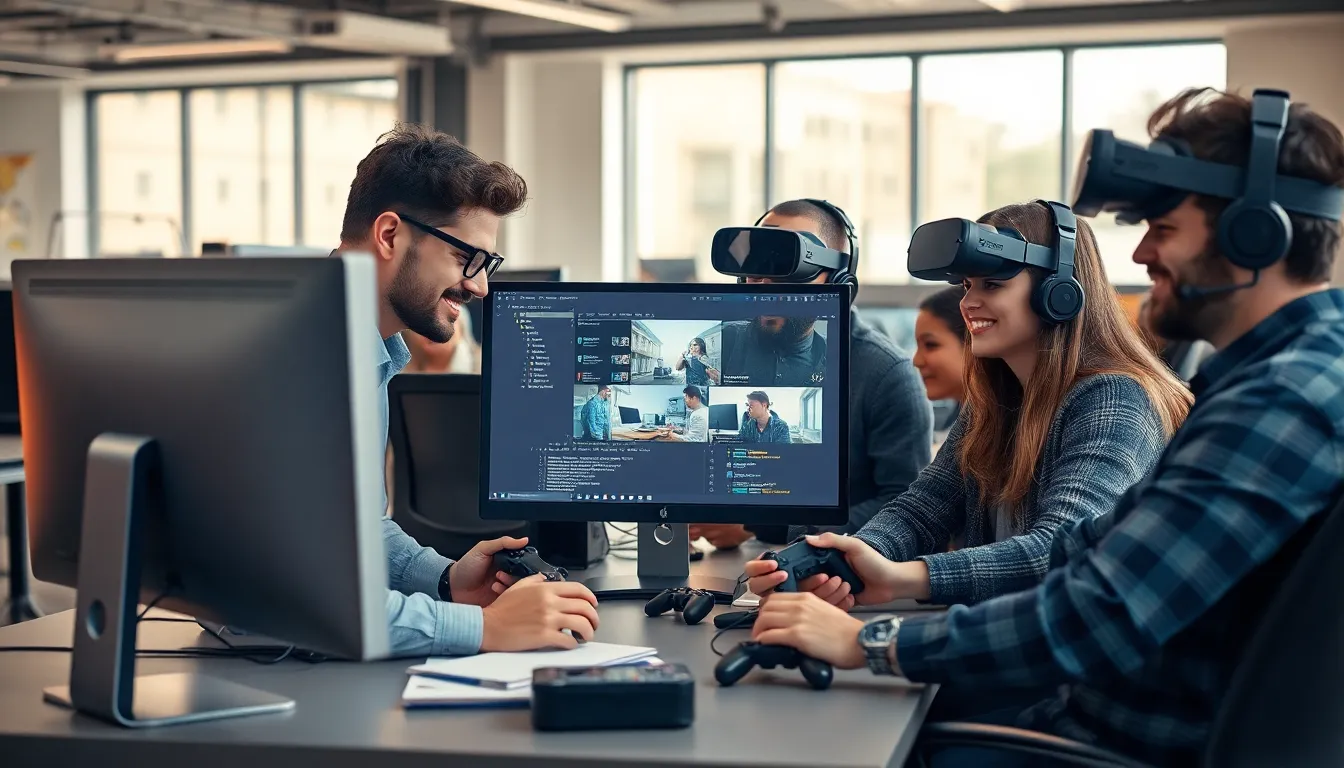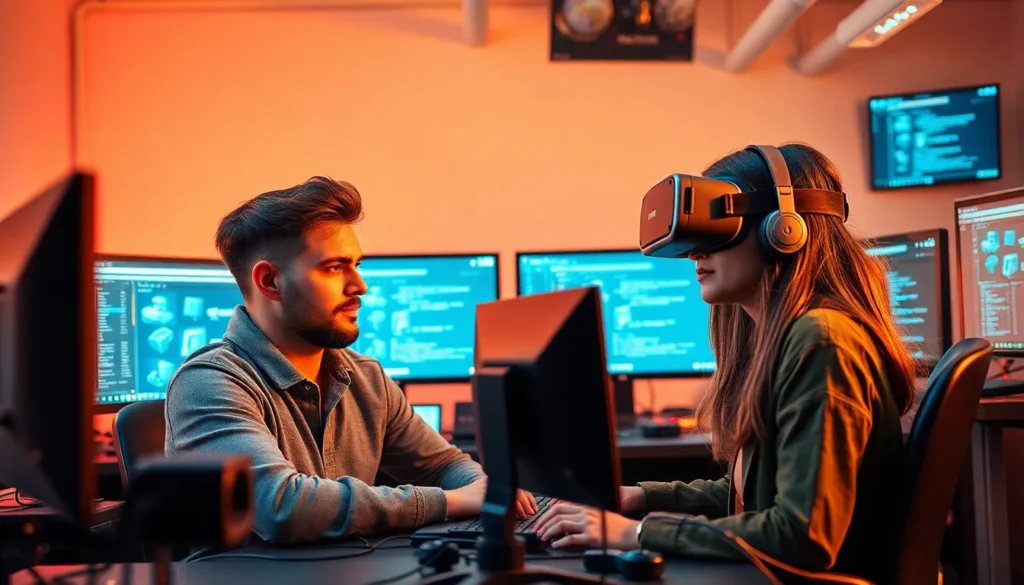Table of Contents
ToggleVirtual reality programming is the magic wand of the tech world, transforming ordinary experiences into extraordinary adventures. Imagine crafting a digital universe where the only limit is your imagination. Whether it’s building immersive games or creating training simulations, VR programming is where creativity meets cutting-edge technology.
Overview of Virtual Reality Programming
Virtual reality programming combines creativity with technology to create immersive experiences. Developers utilize specialized software to design and build virtual environments, enabling users to interact meaningfully. Various tools, such as Unity and Unreal Engine, play a crucial role in this development process, offering robust frameworks for crafting VR applications.
Programming languages significant in VR include C# and C++. C# commonly pairs with Unity, while C++ supports Unreal Engine, providing versatility in project execution. Familiarity with these languages enhances development efficiency and opens opportunities for innovation.
The creation of 3D models is essential in VR, allowing developers to generate realistic representations of objects and environments. Artists often use tools like Blender or Maya for visual asset creation. These models integrate into the VR world, enhancing the user experience.
Implementing physics simulations is another critical aspect. Developers often use built-in physics engines to create realistic interactions, such as object collisions and movements. This realism translates to engaging and believable experiences for users.
User interface design in VR programming focuses on intuitive navigation and engagement. Effective UI ensures users can easily interact within the virtual space. Incorporating elements like menus and buttons within 3D environments increases usability.
Testing VR applications guarantees performance and user satisfaction. Various testing methods identify bugs and performance bottlenecks. Developers often conduct user testing sessions to gather feedback and improve VR experiences continuously. Regular updates ensure these applications keep pace with technological advancements and evolving user expectations.
Key Technologies in Virtual Reality Programming

Virtual reality programming relies on several key technologies that enable developers to craft engaging experiences. These technologies enhance realism, interactivity, and user engagement.
Game Engines
Game engines serve as the backbone for VR development, providing essential tools and frameworks. Unity remains popular due to its user-friendly interface and extensive asset store, allowing for rapid prototyping. Unreal Engine offers advanced graphics capabilities, making it ideal for high-end projects. The flexibility of these engines supports various genres, from games to architectural visualizations. Developers often switch between engines based on the specific project requirements, ensuring optimized performance.
Programming Languages
Programming languages play a crucial role in VR programming, determining how developers implement features. C# is commonly used with Unity, providing a balance between simplicity and functionality. C++ is favored for Unreal Engine projects, offering low-level control for performance-intensive applications. These languages enable the creation of interactive elements and complex behaviors, crucial for immersive experiences. Familiarity with both C# and C++ allows developers to leverage the full potential of their chosen game engine effectively.
Applications of Virtual Reality Programming
Virtual reality programming finds applications across various fields, revolutionizing experiences in gaming, education, and healthcare.
Gaming Industry
The gaming industry benefits immensely from virtual reality programming. Developers craft immersive environments, allowing players to fully engage with the game world. Popular titles, such as Beat Saber and Half-Life: Alyx, showcase the potential of VR to transform gameplay through interactivity. VR not only enhances realism but also introduces innovative gameplay mechanics, creating unique user experiences. Players can physically interact with objects, making challenges more engaging and lifelike. Game engines like Unity and Unreal Engine provide essential tools for developers to create these environments, utilizing advanced graphics and physics engines to enhance player immersion.
Education and Training
Virtual reality programming transforms education and training through hands-on learning experiences. Students can explore complex subjects like biology or history by virtually visiting ecosystems or historical sites. Immersive simulations enable learners to practice skills in safe environments, from medical procedures to aviation training. This approach fosters deeper understanding and retention of information. Education technology companies increasingly adopt VR to deliver interactive lessons that engage students more effectively than traditional methods. By utilizing realistic scenarios, educators prepare students for real-world applications, enhancing the overall learning experience.
Healthcare
Healthcare leverages virtual reality programming for training and therapy. Medical professionals use VR simulations to practice procedures, improving their skills without risk to patients. These realistic scenarios allow for repetition and reinforcement of techniques, essential in high-stakes environments. Additionally, VR supports mental health therapies, offering exposure therapy for phobias or PTSD treatment in controlled settings. Patients can confront fears gradually, with supportive environments that promote healing. Researchers also investigate VR applications for pain management, utilizing immersive experiences to distract patients during treatments or procedures.
Challenges in Virtual Reality Programming
Virtual reality programming faces several challenges that can impact development and user experiences. These obstacles require developers to find effective solutions.
Technical Limitations
Technical limitations present significant hurdles in VR programming. Hardware constraints, such as inadequate processing power and memory, affect the complexity of virtual environments. Low-resolution displays can lead to a lack of realism, diminishing immersion. Additionally, the weight and bulkiness of headsets can cause discomfort during prolonged use, reducing the overall user experience. Latency issues may also arise, impacting responsiveness and potentially causing motion sickness. Developers constantly strive to optimize performance while pushing the boundaries of technology.
User Experience Issues
User experience issues often hinder the effectiveness of virtual reality applications. Many users encounter difficulties navigating complex interfaces, leading to frustration. Designing intuitive controls becomes crucial in addressing these challenges. Furthermore, various individuals experience motion sickness differently, necessitating diversified approaches in design and testing. The need for clear instructions frequently arises, as users may have varied familiarity with virtual environments. Developers prioritize creating smooth, engaging experiences that minimize discomfort while maximizing immersion and enjoyment.
Future Trends in Virtual Reality Programming
Emerging trends in virtual reality programming shape the next generation of immersive experiences. Advances in hardware lead to lighter, more comfortable headsets, enhancing user engagement. Increased processing power allows for more complex environments, providing richer graphics and realistic interactions.
Artificial intelligence features start playing a larger role, offering smarter non-player characters and adaptive storylines. Machine learning enhances user experience by personalizing environments based on user habits and preferences.
Cross-platform compatibility gains importance, allowing users to move between devices seamlessly. Developers prioritize creating environments that work across different systems, minimizing barriers for users. Additionally, cloud-based VR experiences enable remote access to high-quality content without the need for expensive hardware.
Non-gaming applications expand rapidly, particularly in training and education sectors. VR becomes a powerful tool for virtual classrooms, providing interactive learning opportunities. Healthcare sees significant growth, with VR being utilized for surgical simulations and therapy, making it an integral part of medical training.
Community-driven content creation also shapes VR programming’s future. User-generated content fosters creativity while expanding available experiences. Advanced tools simplify the development process, empowering users to craft their virtual worlds without extensive programming knowledge.
Sustainability trends impact VR programming as well. Developers focus on energy-efficient solutions and eco-friendly practices, recognizing the need for responsible innovation in technology. As these trends develop, virtual reality evolves, ensuring immersive experiences become more accessible and impactful across multiple sectors.
Virtual reality programming stands at the forefront of innovation, blending creativity with technology to create stunning immersive experiences. As developers harness the power of advanced tools and programming languages, they’re redefining how users interact with digital worlds.
The diverse applications of VR extend beyond gaming into education and healthcare, showcasing its transformative potential across various sectors. While challenges remain, particularly in user experience and hardware limitations, the future of VR programming is bright.
Emerging technologies and community-driven content are set to enhance accessibility and engagement, ensuring that virtual reality continues to evolve. As the landscape shifts, VR programming will undoubtedly play a pivotal role in shaping the way people learn, play, and connect.




